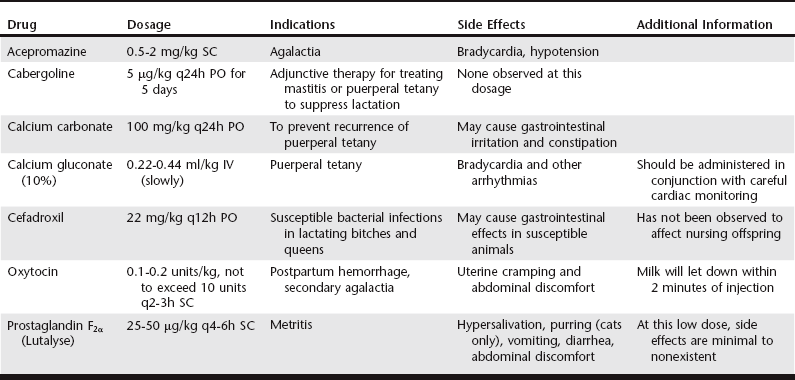Chapter 209 The interval from parturition to weaning, the postpartum period, is typically 6 to 8 weeks in dogs and cats. During the postpartum period, endometrial remodeling at the placental sites occurs, which is histologically complete by 12 weeks after delivery. Postpartum vaginal discharge of lochia, initially dark green in dogs, may persist for 3 to 6 weeks, over which time the discharge changes to reddish brown before it subsides completely. Abnormal events arising during the postpartum period are described in the following paragraphs with a summary of recommended therapies at the end of this chapter (Table 209-1).
Postpartum Disorders in Companion Animals
< div class='tao-gold-member'>
Only gold members can continue reading. Log In or Register to continue

 years old, with an incidence of 10% to 20% in postpartum bitches. SIPS has never been reported in queens, which is curious given the similarity between the canine and feline placenta. The only clinical sign of SIPS is persistent hemorrhagic (with or without clots) to serosanguineous discharge for more than 6 weeks after delivery. However, SIPS may occur in the absence of any vaginal discharge. A presumptive diagnosis of SIPS is made based upon the clinical history. Bitches with SIPS are afebrile and otherwise healthy, which differentiates SIPS from metritis; however, abnormalities within the bladder or vagina also should be ruled out. Abdominal palpation may identify discrete, firm spheroid enlargements within the uterine horns (approximately 2.5 cm in diameter). Abdominal ultrasonography may identify increased fluid in the uterine horn lumen with prominent placental attachment sites. Identification of multinucleated, basophilic staining trophoblasts with highly vacuolated cytoplasm on cytologic examination of the discharge or histologic examination of a uterine biopsy provides a definitive diagnosis. A cystocentesis with urinanalysis and vaginoscopic examination should rule out the urinary tract and vagina as the source of the discharge.
years old, with an incidence of 10% to 20% in postpartum bitches. SIPS has never been reported in queens, which is curious given the similarity between the canine and feline placenta. The only clinical sign of SIPS is persistent hemorrhagic (with or without clots) to serosanguineous discharge for more than 6 weeks after delivery. However, SIPS may occur in the absence of any vaginal discharge. A presumptive diagnosis of SIPS is made based upon the clinical history. Bitches with SIPS are afebrile and otherwise healthy, which differentiates SIPS from metritis; however, abnormalities within the bladder or vagina also should be ruled out. Abdominal palpation may identify discrete, firm spheroid enlargements within the uterine horns (approximately 2.5 cm in diameter). Abdominal ultrasonography may identify increased fluid in the uterine horn lumen with prominent placental attachment sites. Identification of multinucleated, basophilic staining trophoblasts with highly vacuolated cytoplasm on cytologic examination of the discharge or histologic examination of a uterine biopsy provides a definitive diagnosis. A cystocentesis with urinanalysis and vaginoscopic examination should rule out the urinary tract and vagina as the source of the discharge.


